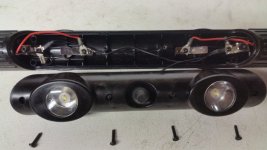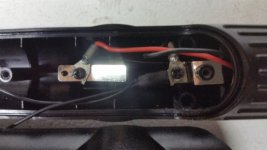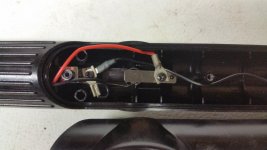Gary - bassguitarist1985
TVWBB Fan
Hey all! I scored an NOS open box grill light off ebay!
There is one more on there linked below at the time of writing this post. Grab them while you can!!!!

Thanks to Bruce and others for blazing the trail. I ordered the LED conversion lights, and some AA to C battery sleeves since C batteries are bit of a dinosaur these days. Plus I always seem to have a plethora of AA's lying around the house.
AA to C Type Battery Sleeve
https://www.amazon.com/dp/B01BOX86HU/?tag=tvwb-20
Lights:
https://www.amazon.com/dp/B076JBZK4T/?tag=tvwb-20
I do plan on disassembling the light to swap the wires inside so that there is no need to flip the batteries. Ill be taking detailed pictures of how to do this. I got plenty of soldering tools, but to do such a simple mod you dont need anything but a standard solder gun.
Hope everyone had a great Christmas

-----------------------------------------------
Edited: Section for LED Conversion Procedure and to modify wiring for batteries to be installed as shown on the device without having to install backwards to work with LEDs. May edit for further clarity at a later date.
***Installing the batteries backwards for LEDS has yielded no ill effects to the device, but to modify for "correct" orientation please do the following mods. This mod can be done with a soldering iron and some small 18AWG wire lengths. You will need to perform these steps for each light/battery bank
1. REMOVE THE BATTERIES!
2. There are two spring clips with wired attached by screws that go to the positive lead of each battery bank. Remove these screws/wires.
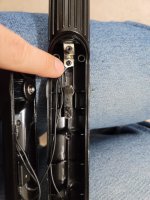
3. There is a thin bare metal wire that sits in a channel traveling to the end cap of the battery banks. This wire terminates to the spring located here under the metal contactor. This wire will need to be cut.
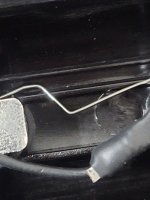
4. Connect the ring terminals removed from the positive battery leads and connect them to the cut wire leading to the negative side of the battery bank. Best if you solder these two points together. The side that is scratched out in red is not connected to anything.
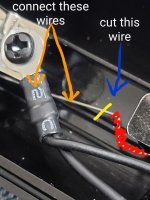
5. Finally, using a short jumper wire. connect the positive lead with the spring clip over to the contactor with the spring underneath it. You cut the wire going to that spring in step 3, so its connected to nothing until this step.
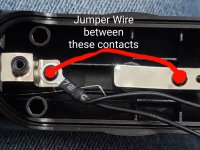
***This mod will make the tip connector of the LEDS as battery positive + and the switch setup will turn on/off the lights on the negative lead which is the barrel connector of the LEDs. This will then allow you to install the batteries as intended and not backwards.
Ed Pinnell had a great idea for a tilt switch mod. I may wind up doing it in the future. Ill table it for now but may come back to it at a later date.
Cheers
There is one more on there linked below at the time of writing this post. Grab them while you can!!!!

Weber Grill. Grill Out Light. Fits Genesis Gas Grills | eBay
<p>Weber Grill. Grill Out Light. Fits Genesis Gas Grills. Condition is "New".</p><br><p>About this item</p><br><p>2 battery-operated lights built into the handle</p><p>Retrofits Spirit 500; Genesis 1000 through 5500 series; Genesis Silver A, B, C</p><p>Stays cool to the touch</p><p>Requires six...
www.ebay.com
Thanks to Bruce and others for blazing the trail. I ordered the LED conversion lights, and some AA to C battery sleeves since C batteries are bit of a dinosaur these days. Plus I always seem to have a plethora of AA's lying around the house.
AA to C Type Battery Sleeve
https://www.amazon.com/dp/B01BOX86HU/?tag=tvwb-20
Lights:
https://www.amazon.com/dp/B076JBZK4T/?tag=tvwb-20
I do plan on disassembling the light to swap the wires inside so that there is no need to flip the batteries. Ill be taking detailed pictures of how to do this. I got plenty of soldering tools, but to do such a simple mod you dont need anything but a standard solder gun.
Hope everyone had a great Christmas
-----------------------------------------------
Edited: Section for LED Conversion Procedure and to modify wiring for batteries to be installed as shown on the device without having to install backwards to work with LEDs. May edit for further clarity at a later date.
***Installing the batteries backwards for LEDS has yielded no ill effects to the device, but to modify for "correct" orientation please do the following mods. This mod can be done with a soldering iron and some small 18AWG wire lengths. You will need to perform these steps for each light/battery bank
1. REMOVE THE BATTERIES!
2. There are two spring clips with wired attached by screws that go to the positive lead of each battery bank. Remove these screws/wires.

3. There is a thin bare metal wire that sits in a channel traveling to the end cap of the battery banks. This wire terminates to the spring located here under the metal contactor. This wire will need to be cut.

4. Connect the ring terminals removed from the positive battery leads and connect them to the cut wire leading to the negative side of the battery bank. Best if you solder these two points together. The side that is scratched out in red is not connected to anything.

5. Finally, using a short jumper wire. connect the positive lead with the spring clip over to the contactor with the spring underneath it. You cut the wire going to that spring in step 3, so its connected to nothing until this step.

***This mod will make the tip connector of the LEDS as battery positive + and the switch setup will turn on/off the lights on the negative lead which is the barrel connector of the LEDs. This will then allow you to install the batteries as intended and not backwards.
Ed Pinnell had a great idea for a tilt switch mod. I may wind up doing it in the future. Ill table it for now but may come back to it at a later date.
Cheers
Last edited:

